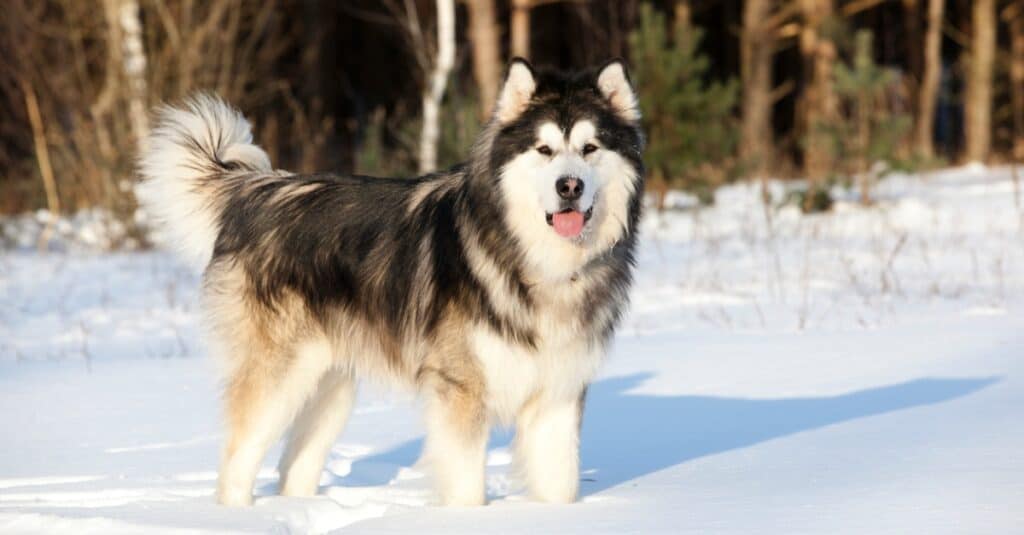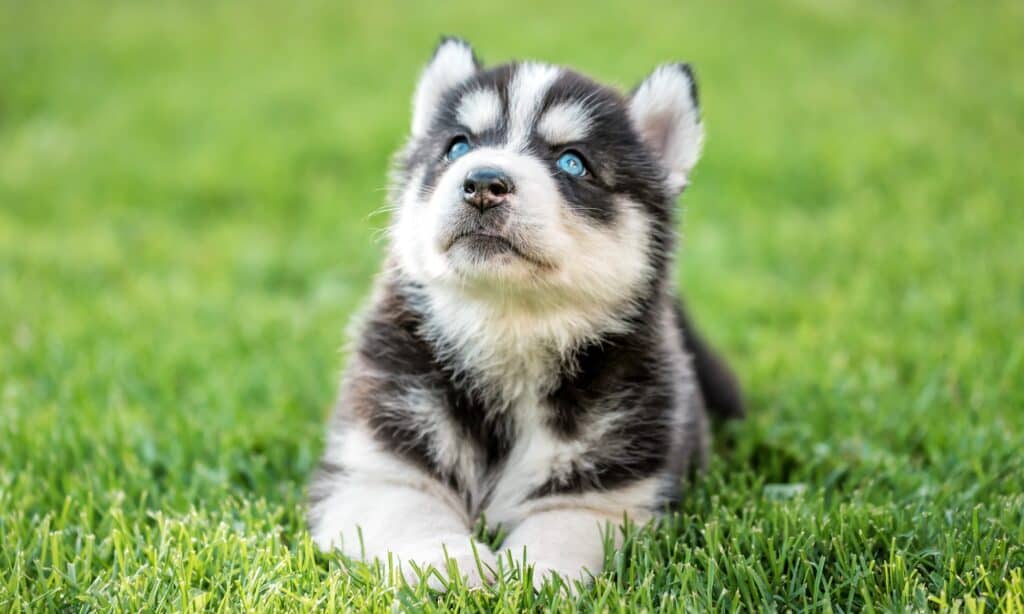The Alaskan Malamute and the Husky (also known as the Siberian Husky) are some of the most famous and sought-after dog breeds in the world. These breeds look very alike and you might even have a hard time distinguishing them. Hence, we have put together a comprehensive comparison of the Alaskan Malamute and the Siberian Husky below. Let’s get cracking.
Comparing Alaskan Malamute vs Husky

| Alaskan Malamute | Husky | |
|---|---|---|
| Size | 23 to 25 inches in height and 75-100 pounds in weight. | 20-24 inches in height and 35-60 pounds in weight. |
| Appearance | Muscular, dark, and medium-sized eyes. Mostly white markings on the face, triangular ears, thick fur, and long, curly tails. | Blue eyes, heavy double coats with undercoats, white markings on chest and legs. Long and bushy tails. |
| Location | North America (originally bred in Northwestern Alaska. | North America (originally from Eastern Siberia) |
| Lifespan | 10-12 years | 12 to 15 years |
| Diet | Naturally omnivorous. They feed on normal high-quality dog food. | Also naturally omnivorous and they feed on healthy dog food with high protein levels (20-32%%). |
| Behavior | Highly intelligent, friendly, and animated; welcoming to strangers, strong prey instincts, occasional barking. | Cheerful demeanor, they enjoy company with other huskies as well as humans, a bit independent and stubborn. |
The Key Differences Between an Alaskan Malamute And A Husky
The major differences between the Alaskan Malamute and the Husky are found in their size and lifespan.
While the Alaskan Malamute stretches 23-25 inches long and weighs between 75-100 pounds, the Husky is 20-24 inches in height and only weighs about 35-60 pounds. Also, the Alaskan Malamute can live between 10-12 years while most Huskies live as long as 14-15 years.
Let’s delve into more details about the differences between the Alaskan Malamute and the Husky.
Alaskan Malamute Vs Husky: Size

Malamutes measure about 23-25 inches long, with a massive weight of 75-100 pounds.
©iStock.com/Liliya Kulianionak
Alaskan Malamutes are taller and heavier than huskies on average. Malamutes measure about 23-25 inches long with a massive weight of 75-100 pounds. Huskies, on the other hand, weigh just about 35-60 pounds and their height often falls between 20-24 inches.
On average the Alaskan Malamute is incontestably the larger breed.
Alaskan Malamute Vs Husky: Appearance

Siberian Huskies have cute blue eyes, double coats, long and fluffy tails, as well as white markings on their chest and legs.
©Sbolotova/Shutterstock.com
Taking a cursory glance at both animals might have you thinking they are the same breed because of the similarities in appearances. However, there are some subtle differences, as we are about to see.
The Alaskan Malamute is typically muscular with brown, medium-sized eyes, small triangular ears, and peculiar markings (mostly white) on the face. Malamutes also have thick furs with colors ranging from black and white to red and white to grey not to mention their beautiful, curly tails which notably loop over their backs.
As for the Husky, they have cute blue eyes, double coats, long and fluffy tails as well as white markings on their chest and legs. Much like the Malamutes, Huskies also have a variety of fur colors including black and white and red/white. However, the agouti coloring is exclusive to huskies. Huskies also have smaller heads and more compact ears than the Alaskan malamutes.
Alaskan Malamute vs Husky: Behavior

Alaskan Malamutes are among the quietest dog breeds and are not known to be excessive barkers.
©iStock.com/ANATOLii SAVITSKii
Alaskan Malamutes and Huskies have very similar behaviors and temperaments. Both animals are friendly, affectionate, and possess an impressive level of intelligence.
Malamutes even extend their cheerfulness to strangers, so the position of a “guard dog” doesn’t suit them much. They are also among the quietest dog breeds and are not known to be excessive barkers. Also, Alaskan Malamutes have been described as having “strong prey instincts” which means pet owners cannot keep smaller animals around them.
Experts say huskies tend to be independent and stubborn and it typically takes a lot of training to subject them to human control. Besides that, they are affectionate, cheerful, and good with children and humans.
Alaskan Malamute vs Husky: Diet
As you probably guessed, the Alaskan Malamute and the Husky are both omnivorous animals. Since they are mostly pet dogs, their diets are specially curated according to their weight maintenance requirements and other health requirements.
For the Alaskan Malamute, we advise a diet comprising the Purina Pro Plan Large Breed & Giant Breed Chicken & Rice Adult Dry Dog Food & Wet Dog Food. It contains enough protein to help build the Malamute’s muscle as well as calcium, phosphorus, and glucosamine to keep their joints at a top-notch level for years to come.
One of the best dog foods for the Siberian Husky is the Blue Buffalo Wilderness High Protein Natural Adult Dry Dog Food. It guarantees protein for healthy muscles, fatty acids, antioxidants, and vitamins amongst other nutrients. This will make for a long, healthy living for the pet and fewer issues for the owner. We must mention that working huskies will need diets with higher calories to meet up with the demands of their work.
We advise getting an animal expert to help with the best and most optimal food selections for both of these lovely dogs.
Alaskan Malamute vs Husky: Health Issues

Huskies are healthier than Malamutes and are the most preferred of the duo health-wise.
©iStock.com/vovashevchuk
Like most bred dogs, Alaskan Malamutes and Huskies are both prone to certain health problems, some of which can be debilitating. However, Alaskan Malamutes are prone to more health issues than Huskies as we are about to find out.
While Alaskan Malamutes are naturally strong and muscular, their weakness lies in their vulnerability to certain diseases. These include hip and elbow dysplasia, thrombopathia (clotting problems), polyneuropathy (which may cause limb and facial paralysis as well as delayed heartbeat and spatial disorientation), chondrodysplasia (dwarfism/stunted growth), day blindness, and von Willebrand’s disease.
Huskies, however, are a generally healthy breed, and the most common health issue they face is juvenile cataracts. They are healthier than Malamutes and are the most preferred of the duo, health-wise.
Dealing with these diseases can be rather frustrating hence, we advise thorough evaluation and getting a clean bill of health before getting any of these pets. Regular visits to a trusted veterinarian are also advised for thorough examinations and quick detection.
Ready to discover the top 10 cutest dog breeds in the entire world?
How about the fastest dogs, the largest dogs and those that are -- quite frankly -- just the kindest dogs on the planet? Each day, AZ Animals sends out lists just like this to our thousands of email subscribers. And the best part? It's FREE. Join today by entering your email below.
Thank you for reading! Have some feedback for us? Contact the AZ Animals editorial team.








